Text
SGP Ritual for the Super Blood Blue Moon Eclipse
This ritual is designed to fortify ourselves with inner strength, cunning, bravery and the will to persevere. Into the underworld we roam like werewolves and creatures who trespass the boundaries of the normal, finding a sacred freedom there. It can be performed alone or in groups.
Background:
A Blue Moon is the second full moon in a month. For some Australians, it won’t technically be a Blue Moon as it takes place after midnight on the 31st of January.
A Supermoon is a full moon that appears extra-large and bright in the sky; the moon is at its closest point to the Earth in its elliptical orbit.
A blood moon is a colloquial term for a total lunar eclipse. The moon will be passing through the darkest portion of the Earth’s shadow (the umbra); some of the light reflected off the Earth’s atmosphere will make it glow a luminous red.
The site timeanddate.com has useful information about times and the direction the moon will be travelling through the sky in your area.
Tools:
Spring water
Dragon’s blood stick incense
Clean bowl
Red candle
For afterward:
Salty snacks, journal & pen
Kitchen substitutes:
Chilled or filtered tap water, oranges/orange oil, roses, rose petals, other incense, ext. Hot water poured over herbs like a tea can produce pleasant scents as an alternative for people sensitive to smoke. A tea light in a red glass, ext.
Location:
An outside liminal space, such as the beach, a park, your yard, ext.
If being outside isn’t suitable, by a (preferably open) window.
The eclipse can also be watched live online here:
https://www.timeanddate.com/live/
Setup:
Create an altar to be the focus for the working, and practice/learn the chant.
Place the red candle in the center, with a stick of incense on each side.
Suggested altar items:
Black and red objects such as fruit or statues
Bones, mushrooms, and other items associated with death and the underworld
Sea salt
The Strength and Moon tarot cards
Red stones: sandstone, jasper, carnelian ext.
Moon-related stones: selenite, moonstone, quartz
If you’re a person who presently menstruates, related sanitary items
Sand or sea water
Chant:
Bathed in blood and clothed in flesh
Into the darkness we dare step
The ritual:
Prepare in a manner that befits your practice. Ground, ward, cast a circle, enter into magical space/headspace.
Read out the ritual intention three times (Once by the ritual leader, then thrice as a group if working with others).
Ritual intention:
Between the worlds, we embrace our birthright as the strange ones.
Have the ritual leader read out the liturgy:
Liturgy:
The dominion of the othered, the queer, the witch, the seer, is an ability to step between the worlds while fully inhabiting none. There is power in our unique perspective, value in our rarity. In the underworld we find cradle, truth and power. The fertile ground for challenge, growth, the hidden and obscene. Like the darkness, sovereign and strong, we cannot be denied.
Begin the chant.
At the height of the eclipse, direct your hands and arms upwards to the moon and envision using them to guide energy like a silvery light down into the bowl of water, turning it into blood.
Take turns drinking deeply from the bowl.
Let the chant naturally fade into a hum, and then silence.
Lay back and watch the rest of the eclipse, close your eyes or stare into the candle. Allow yourself to feel the power of the spring water coursing into your veins and enriching your blood, or engage in visionary experiences.
When it feels appropriate, return.
Blow out the candle, snuff the incense and close the circle, banish, thank, ground.
Eat some salty snacks or the food off the altar.
Journal your experiences.
#witch#full moon#witchcraft#witchblr#full moon ritual#blood moon#super blood moon#lunar eclipse#spell#pagan#blue moon
0 notes
Text
Dragon’s blood ink: The search for a recipe that actually works
Unsurprisingly, making Dragon’s blood ink is not as straightforward as all the online tutorials with the same copypasted (mis)information make it seem.
The recipe that can most easily be found online is a combination of alcohol, gum arabic and dragon’s blood resin. I put this to the test, and found success hinges on the qualities of the ingredients.
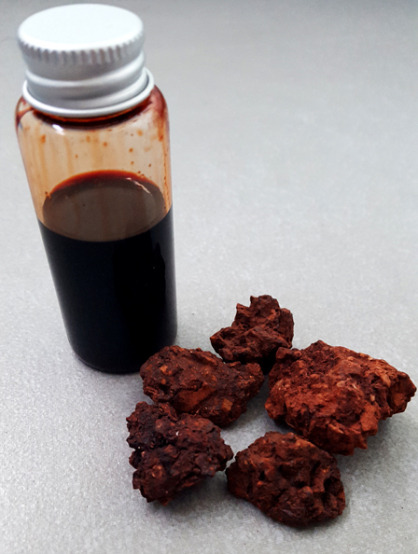
Dragon’s blood ink and resin.
Part 1: the experiment.
The alcohol:
First test, Polmos Spirytus rectified spirit. It’s the highest purity alcohol (95%) available to the general public in Australia. It’s also $70 per 500ml. I wasn’t willing to spend that much money on booze I’m not going to drink!
So we move down the price scale to vodka. Most vodkas are around 37% alcohol, the rest being water. Due to this high water content, the resin was reluctant to dissolve, and when it did, the drying time was prohibitively long.
My next unsuccessful experiment was with methylated spirits (denatured alchohol). Although cheap, it smells dreadful and leaves a foul smelling residue behind when used as an ink due to the additives which make it undrinkable.
Finally, success with Isopropyl alcohol (IPA). It’s only $9 per 250ml, 99.8% alcohol and evaporates quickly and cleanly. It can be found at specialty electronics stores such as Jaycar.
The gum arabic:
The purpose of gum arabic in ink is to increase the viscosity of the fluid, allowing it to grip the brush.
The problem: gum arabic isn’t soluble in alcohol. Trying to dilute it in water first and then adding it to the alcohol resulted in a stringy, goopy mess.
I couldn’t find any alcohol soluble equivalents, so I left it out.
The resin:
As I covered in my last post, there are primarily two types of resin on the market.Daemonorops draco is not alcohol soluble. If mixed with alcohol, this palm draco resin may turn the alcohol a muddy brown colour, but will quickly settle to the bottom.
Dracaena cinnabari and Draceana Draco will both readily and quickly dissolve in alcohol and are suitable for creating ink.
Part 2: The recipe
What you’ll need:
Dracaena resin. Elfhame’s Apothecary were very kind to provide me with some genuine D. cinnabari, or ‘medieval dragon’s blood’ for testing. It can be purchased here.
Isopropyl alcohol
A storage jar with a secure lid
2 beakers, open mouth jars or
measuring cups.
A brush or other writing implement
Some patience

Step 1:
Powder the resin.
Because my mortar and pestle are quite large and the material very precious, I wrapped it up in baking paper and crushed it using the pestle alone, which minimizes wastage.
As it is quite readily soluble in alcohol, D. Cinnabari does not need to be crushed very fine.
Step 2:
Pour the powder into one of the open mouth containers. Add the alcohol and watch as the blood red colour instantly begins to seep into the liquid, quickly transforming it into a rich, black-red fluid. The process is quite captivating to watch and the resemblance to real blood is striking.
Step 3:
Let it settle for a couple of hours, then gently skim the alcohol off into the second container by carefully pouring it and leaving the bark chunks behind.
Due to the way in which Dracaena cinnabari is harvested, there will be a substantial amount of bark debris left.
Repeat this process until the alcohol runs relatively clear, leaving behind only spent fragments of bark.
Step 4:
Leave the second open-mouthed container with no lid in a warm, dry place and allow the alcohol to evaporate down.
Due to the nature of the ink I didn’t find it necessary to filter it further.
Use a brush to make some test marks to gauge the correct concentration. When enough alcohol has evaporated to create the right concentration of pigment, bottle it in a sealable jar. If it becomes too thick, simply add more alcohol.
Conclusion:
It should give a luxurious red ink, but not be too thick as to remain tacky while drying.
Note: keep alcohol on hand for cleaning brushes/writing implements, as it won’t wash off using normal methods. For this reason I recommend using a fine paintbush for writing, as they are easier to clean.
The process is a little messy, but very simple and easy. By making it yourself, you can be assured the ink is genuine. As pure Dragon’s blood ink dries scentless, this also opens up the possibilities for experimenting with adding fragrances and resins to create Bat’s blood or Dove’s blood ink and other concoctions.
1 note
·
View note
Text
The surprising truth about counterfeit Dragon’s blood
The truth is you haven’t been buying Dracaena draco, and the surprise is; that’s a good thing.

Dracaena cinnabari in it’s native habitat on the Socotra archipelago. Photo credit: Wikimedia commons.
Part one in a series on Dragon’s blood resin.
The other Dragon’s blood; latex, dye and poison
In a modern magical context, Dragon’s blood is often erroneously assumed to simply be the resin sap produced by the Dragon tree, but as with most things in this world, the truth is more nuanced.
The Calamus, Pterocarpus and Croton genera contain plants which produce gums, latexes and resins which have been labeled as Dragon’s blood; these have been used medicinally and as dyes. One example, the latex of the Sangre de drago , Croton lechleri, native to South America, can be used as a natural adhesive bandage.
As for their use as pigments, due to the nature of vegetable dyes, kino gums may resemble blood when oozing from wounds on a tree but often do not produce a red colour pigment.

The familiar kino of the Eucalyptus, Corymbis calophylla. Credit: Wikimedia Commons
Outside of ethnomedical studies and natural remedies, these forms of Dragon’s blood are of less prevalent concern to modern paganism.
Next up we have the brilliant but deadly vermilion, also known as Dragon’s blood, or China red. This was traditionally produced from powdered mineral cinnabar. Cinnabar is a highly toxic form of mercury sulphide which was used in antiquity as a dye, cosmetic and in jewelry. Unsurprisingly you’re not likely to encounter this stuff on the market in its natural form, although vintage Chinese cinnabar lacquered artifacts are attractive to collectors. While cinnabar is very dangerous, with careful handling the lacquer renders it relatively inert.

A wooden plate lacquered with cinnabar. Photo credit: Wikimedia commons
Finally, the form that most of us are more familiar with; Dragon’s blood incense. This is usually derived from either the Daemonorops or Dracaena genera; only the latter of which is also used as a dye.
The true Dragon’s blood tree
The Dragon’s blood resin you see for sale is very unlikely to be from the true dragon’s blood tree. It’s also worth noting that any form of genuine Dragon’s blood essential oil does not exist.
The popular houseplant known as Lucky bamboo, or Chinese water bamboo, Dracaena braunii, is actually a much closer relative to the genuine Dragon’s blood trees. Continuing the theme of misattribution, it is not Chinese nor a bamboo; it’s native to Cameroon in West Africa.
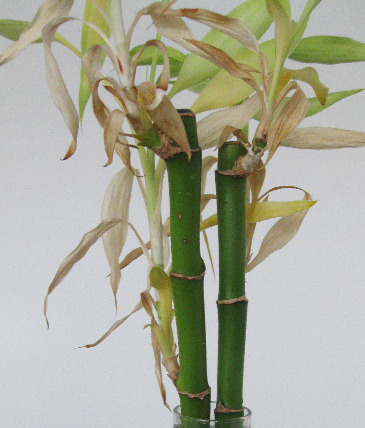
Some lucky bamboo growing on my altar.
The family it belongs to, Asparagaceae, gives us the Agave used in the production of tequila and, as one could guess from the name, the vegetable asparagus.
When people talk about the Dragon’s blood tree, they are usually referring to Dracaena draco or Dracaena cinnabari. Although there are other Dracaena species harvested for their resin, I’ll be focusing on these two as they’re the most widely known and referred to. Due to its distinctive long trunk with leafy branches extending from the crown, these trees are sometimes called a Dragon’s blood palm. This is unfortunate because it is not a palm, while its impostor is.

Not a palm. Photo credit: Wikimedia commons
Dracaena draco is a popular ornamental garden tree in Australia, whereas D. cinnabari is much less sought after due to its extremely slow growth rate and similar appearance. Given favorable conditions, the average Dragon’s blood tree takes 10 years to reach a height of just over one meter.
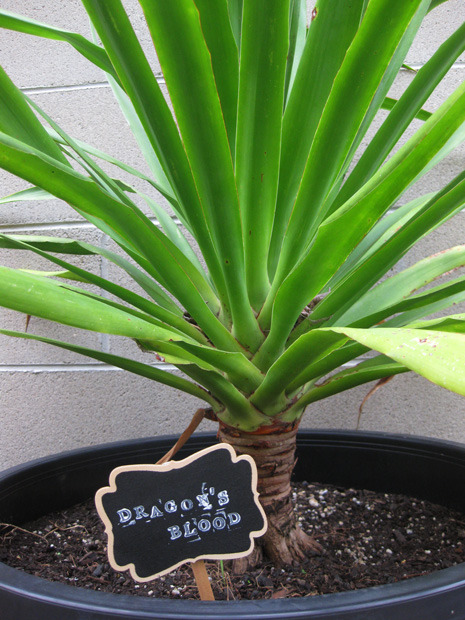
My child. I picked up this D. Draco at Bunnings when it was only 20cm tall. It’s now 3 years of age.
Unfortunately both D. Draco and D. Cinnabari are threatened species; vulnerable to extinction in their native habitats. Both trees have an incredibly slow growth cycle, taking over a decade to reach their first state of reproductive maturity. Habitat loss, over-harvesting, desertification, climate change and modern agriculture techniques all present hazards to their survival.
The common Dragon’s blood cane palm Daemonorops draco, sometimes referred to as Demon cane due to its thorns, is cultivated in Southeast Asia, with much of the resin on the market coming from Indonesia and Thailand. Endemic to the tropics close to the equator, the Arecaceaefamily of plants also gives us raffia and coconuts.
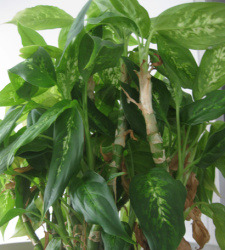
Not to be confused with the Araceaefamily like this Dieffenbachia dumb cane. Because whoever named them hated dyslexic people.
Daemonorops draco is the stuff you’ll commonly see for sale. I often see Dragon’s blood in stores labelled as Dracaena draco, but it’s increasingly rare and difficult to find genuine Dracaena resin.
Although it’s unfortunate that so many otherwise reputable outlets are mislabeling their product, the reasons I posited this as a good thing are threefold. Firstly, Dracaena draco resin, due to its rarity is prohibitively expensive.
Secondly is the issue of the commercial exploitation of an endangered species, making the use of a plentiful alternative attractive. Harvesting Dracaena resin leaves the tree vulnerable to fungal infection which may kill it. Due to this vulnerability and their low numbers, it is favorable that the commonly available Dragon’s blood incense is derived from the plentiful and fast growing Daemonorops draco, as demand for the resin could not be satisfied otherwise.
Thirdly is a matter of personal opinion in regards to their aromatic properties. The rare D. cinnabari and D. draco are almost entirely scentless unless actively being burnt. As Dragon’s blood resin is used in all sorts of aromatic products beyond incense, such as soaps and papers, these would lose their appeal if Dracaena was used in things that aren’t intended to be set on fire.
Conversely the subtle but commanding, warm, masculine scent of Daemonorops draco is quite pleasant and apparent even when not lit.

This red sigil chalk I made using palm Dragon’s blood should definitely not be set on fire.
Now that we’ve established the difference between these three types of Dragon’s blood resin, what about their aromas, magical uses and the mysterious Dragon’s blood ink?
In my next posts I will demonstrate the recipe for Dragon’s blood ink and explore the properties of Daemonorops draco, Dracaena draco and Dracaena cinnabari in greater detail.
1 note
·
View note
Text
Blood Magic
This article has a frank discussion of the uses of blood and photographs of dried blood on paper-all pictures of fresh blood/more graphic images are posted as links. I also refrained from making any ‘blood for the blood god’ jokes even though I really wanted to.
All experiments are valuable; here’s one that didn’t go so well-using fresh human blood as ink.
It’s a pity I didn’t have this project in mind when I was trailing surgical drains [GRAPHIC IMAGE] everywhere I went while recovering from top surgery (a double mastectomy) which would have provided a more than ample supply of human juice.
All the information I could find relating to blood painting generally assumes the blood compounds have been processed and rendered into a pigment-any cursory internet search for blood ink will only net you results about printer ink being more expensive by volume.
Once outside the body, pure blood clots very fast; rapidly turning into a goopy mess. While still in liquid form it displays good brush adhesion and is easy to use as a caligraphy medium, but the working time is a matter of mere seconds.
I experimented with diluting blood with alchohol, water and liquid gum arabic; none of these had any effect on stopping or slowing coagulation.
I wanted to find if there were any other easily available household items that could be used in such a manner.
Somewhere in the dusty attic of my memory, I had filed away a bit of heresay that food grade Tartaric and Citrid acid could be used as anti-coagulants.
At this point the supply I was willing and able to extract from myself was dwindling severly, so more conclusive results could probably be gained with samples larger than a few drops.
Between the citric acid, the tartaric acid and a combination of the two, I couldn’t discern any difference between them.
When a substantial amount of acid was added to blood, it immediately turned a rather unappealing shade of dark brown and became very sticky-remaining so without drying. Pure blood, although also sticky at first, usually dries extremely rapidly.
When the tiniest amount of acid was added the blood only darkened a shade; this also reduced the stickiness-on such a small scale it was difficult to say if it was wholly eliminated.
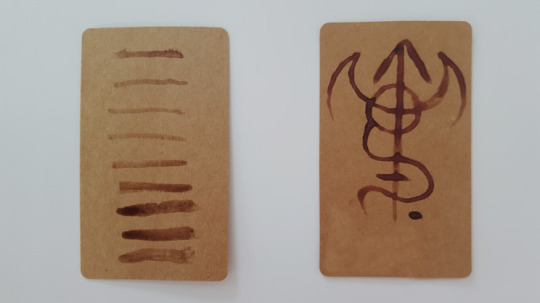
Image description: marks painted in dried blood on two squares of brown paper.
On the left is a series of marks testing the consistency of blood/acid blends, and on the right is a sigil drawn in undiluted blood.
Although the difference is subtle, the card on the right, pure blood, is a richer red colour than the browned acid/blood mix.
I could have expanded my experiments to using frozen coagulated animal blood, and I may one day revisit this topic, but beyond occasionnaly using my own blood extracted using diabetes lancets as an ad-hoc offering, blood magic is not high on my list of interests. I’ve invested a lot in making sure as much of my insides remain inside as I can, and I’m too germaphobic to want much contact with anyone else’s.
Could either of these acids, used in very tiny amounts, be effectively used to give fresh human blood a uniform texture? I don’t know; I’m no phlebotomist and my knowledge of chemistry is weak at best.
My recommendation to anyone wanting to try painting a sigil or ritual message in blood, is to simply work very fast.
0 notes
Text
The Animist Apocalypse-Mad Max and the importance of environmentalism
“Where must we go, we who wander this wasteland, in search of our better selves.”
-The First History of Man, Mad Max: Fury Road, 2015
In post-apocalyptic fiction, signs of an animistic culture are often plentiful in the set dressing; from skull motifs to more subtle expressions of sympathetic magic, to taboos which define when it is safe to travel through an area due to unseen natural forces that demand respect-lest one perish. In these worlds people live in a reality strangled of meaning; stripped of all but the most basic diversions and amusements, choice, and even hope.
Isaac Marion’s post-zombie apocalypse novel Warm Bodies illustrates an America in which people survive by sheltering in huge sports stadiums. Supplementing their diets with vitamin pills and barricaded against outside forces; scouting parties must invade dangerous territory-the former cradle of suburbia, in order to extract supplies.
A sharp cultural contrast to this is the nuclear wasteland of Dimitry Glukhovsky’s Metro 2033 series, in which the last vestiges of humanity eke out an existence in Moscow’s vast and sprawling underground rail network. The people of the tunnels farm pigs and mushrooms and must forever remain vigilant against the mutant creatures that constantly test their defenses; an outwards force pushing inwards. Meanwhile political conflicts tear apart the communities within.
Apocalyptic fiction presents fears for the future unique to the inhabitants of the culture it was born from, but it also has a unifying philosophical theme; what does it mean to be human, and what is the point of being alive? People do not simply fight to live another day; they struggle to nourish their souls with scraps of beauty, love and meaning.
In these inhospitable worlds, the rules for survival have changed; nature is no longer abstracted and the ability for people to adapt the environment has become limited-a dire predicament for anyone from a wealthy post-industrialized culture.
One of the things that makes this genre so appealing to me is that this lifestyle shift usually brings with it a return to an animistic worldview of unity with the natural world.
The recent Mad Max: Fury Road has some beautiful examples of a fictional post-apocalyptic animist culture.
It’s a film in which a band of eco-feminists fight the forces of war, patriarchy and greed against a post nuclear-exchange desert landscape. Also car chases. And explosions.
Between explosions, we get a glimpse of the social order of the War Boys. They ritually scar their bodies with engine schematics, and their medical professionals are referred to as ‘organic mechanics’, displaying an inextricable unity with their vehicles. They have an oral tradition of storytelling in which dying a good death is of utmost importance, combined with a belief in reincarnation and the need to be deemed worthy-a worth which is determined by their usefulness to their master. A film lush with symbolism, this blending of human and machine is of vital importance-the tyranny of Immortan Joe positions this as a method of control and objectification-as a means to strip away autonomy. People are things, and things are disposable.
The skull motif is ever-present; the skeletal form of Furiosa’s missing arm is painted on the side of the war rig, the sickly war boys are hairless and white, and the very symbol of Immortan Joe’s rule is a blending of the steering wheel and the skull. Skeletons are things, and things do not deserve respect.

When Furiosa learns of the destruction of her childhood haven, she rips off her prosthetic arm and howls in despair. This completes her symbolic rejection of her service to Immortan Joe, which had stripped her of agency and personhood. But just as we are now unable to colonize other planets, there is nowhere left to go; the salt flats extend eternally like the inhospitable emptiness of space.
So our heroes turn back to the Citadel to take back the world. The symbolic relationship between Furiosa and her arm has changed; when she straps it back on, she is reclaiming a right to live in the world cooperatively, interfacing with it with respect, and as a part of her. She is no longer a resource to be exploited.
As Nux’s war paint wears off, we see him as an enslaved child, made terminally ill by the folly of dictators. Finally, he is able to find his better self in service of a great and sincere sacrifice.
It’s no coincidence the Keeper of the Seeds, member of the resilient and free Vulvalini, tried to save as many plant species as she could-not just crop varieties directly useful to humans.
‘Who killed the world?’ asks Angharad, and the answer is damning.
In these fictional scenarios animism flourishes because there can be no disconnection from the land; it is an actor itself and not merely acted upon. The stakes are always high; the natural world must be respected. So fraught with danger, the apocalyptic landscape represents a world that humans have made almost uninhabitable for themselves as they stare down extinction. Be it over wealth inequality, war, climate change or resource scarcity, fictional apocalypses are almost singularly the result of human hubris.
For me, a core part of my modern pagan animist beliefs is respect, cooperation and balance. The importance of respecting the natural world, as a part of us and not an outside resource should be self evident-if we muddy up our biosphere, everyone suffers. My animism is inherently environmentalistic, but everyone should be concerned with the plight of the natural world, regardless of their spiritual alignment.
Mass-scale, global environmental exploitation needs to be curbed. Let’s hope we can make it happen before the advent of a nuclear wasteland.
3 notes
·
View notes
Text
Kuda Lumping; intense trance, dance, ritual and spirit possession
This is a review/chronicle of my experiences at Kuda Lumping at Supersense Festival, feat. Padepokan Gunung Ukir.
Note on the date:
This post relates to something that happened last year, but due to a catastrophic tech failure I lost all the accompanying photos; it’s been kicking around in my drafts ever since.
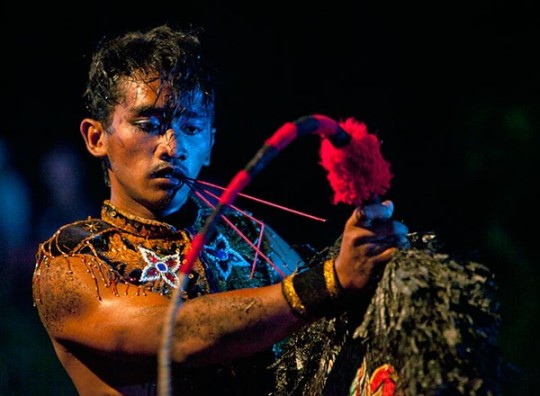
Photograph by Tim Mummery
On the 7th August 2015 I attended the Arts Centre’s Supersense, which promised to be a ‘festival of the ecstatic’. Being a creature of liminal spaces, this tagline instantly caught my attention; I was not disappointed.
Upon arrival, the audience were ushered into the Arts Centre through mysteriously lit service corridors; pathways were created by a bath of coloured light; violet, teal and ochre-leading to the different colour-coded performance areas. Just by entering the building via these ordinarily off-limits routes, the audience was already traversing a boundary away from mundane reality.Taking the teal path, I wandered onto the main stage of the State Theatre; a rare treat to look out over the theatre’s seating from the perspective of the stage itself, and a metaphor for Kuda Lumping’s difference from the usual Western notion of a strict audience/performer divide.
Situated at one side of the stage, across from a rope circle loosely partitioning the audience from the performers, was a stage platform covered in various musical instruments and offerings, including many bananas and coconuts. When I entered, a number of musicians were seated there, performing traditional Javanese music, surrounded by the intricate and lavish wooden platform which included a scaffold decorated in gold dragons holding up huge hide drums.
After a time, the man who appeared to be the master of the ceremony, who I assumed was the Dukan, the mystic Pak Ki Iswand, came forward to the centre of the circle to light incense and invoke the spirits. Unfortunately English is my sole language, and I’m unfamiliar with Javanese culture, so my interpretation of what was happening before me is heavily influenced by my own experiences with ecstatic ritual.
With a fantastic sense of showmanship, he began reciting prayers, negotiating with the spirit world and inviting magic into the space.Large white stage curtains lit with the festival’s s signature creative use of coloured lighting descended downwards to just above head height, creating a border around us, and with them I could feel the energy in the space being raised-I’m normally not very energy sensitive, but this was hard to ignore. The magical ceremonies I’ve participated in generally don’t invite spectators, nor allow people to come and go freely; here however, people were casually milling about, coming and going already.It was at this point I regretfully had to leave to go see Tao Dance Theater’s ‘5’, since several of the performances during the evening overlapped. The dancers had gracefully slid their bodies across one another to a contemporary ambient soundscape, appearing as one fluid, ever-shifting organism reminiscent to my mind of a sea anemone.When I returned, the Kuda Lumping ceremony had increased dramatically in intensity. I found a comfortable spot on the floor near the edge of the rope circle and settled in to watch the rest. The musicians had increased the tempo, and the performance area was alive with a substantial number of people; both performers and those tasked with seeing to their welfare. Dancers were riding colourfully decorated woven bamboo horses with spectacular choreography, swirling around, seeming to reenact an important battle.As the energy was raised by the music, dance and supervision from Pak Ki Iswand, the performers became more receptive to trance states. Once the ceremony had reached a fever pitch, it became easy to spot when and which of the performers had become possessed. The ritual lost it’s repetitive, twirling, rhythmic choreography as more and more succumbed.When a spirit entered an individual (they appeared to my mind to be ancestral beings) the change was palpable. A fit young man, possessed by a child-like spirit fussed and demanded comfort, a demure young woman was possessed by a forceful warrior, her dancing movements whip-sharp and graceful. Another playfully offered to share bananas with audience members sitting by the rope border, insistent that they at least have a taste, using gesture to cross the language barrier. Another relished in impressing by chewing up and walking over an assortment of glass, seemingly immune to damage and fear.
Possessed individuals wandered about performing great feats of gymnastic athleticism, ate whole raw chilies, swallowed razor blades, chewed up glass fluorescent tube lights and ripped apart coconuts with their bare hands. All with an awe-inspiring ferocity and intensity, overseen by the mystic and his helpers, periodically cracking whips.The performers were dressed in colourful traditional clothing, and sometimes large masks; the colour and motion and scent of incense alongside the music and skin-tingling energy created a powerful environment for all the senses.When a spirit departed from it’s host, their body collapsed in exhaustion and they were quickly picked up and carried away out of sight, presumably to receive aftercare; they seemed to have been full black-out possessions and I doubt they remembered what had occurred.Some of the musicians, who had been playing up to that moment, went limp with a loud crash and almost fell off the stage as spirits unexpectedly took hold of them; needing a moment to adjust to piloting their host bodies, stumbling an awkward for a short period.
At one point an audience member, an elderly Indonesian man suddenly joined the ceremony as a spirit leapt into him too.It was spectacular, awe-inspiring and made me extraordinarily happy to see this ecstatic cultural tradition so very alive, contemporary and relevant.The ceremony charged on in full force until there were few performers or helpers left, at which point it wound down fairly rapidly.After it had closed, we were invited to stay and share a meal; my favourite method of grounding. An impressive, generous spread of traditional satays, curries, roasted chicken pieces, rice, salad and quite a few things I didn’t recognize were laid out on a mat of the woven horses on the floor.I grabbed a plate of food and settled down out of the way on a lounge in the lobby, where I chatted briefly with an Indonesian woman about the experience. She asked if I found what I had seen confronting; I relayed that I simply felt extremely privileged to have seen what I did; not mentioning that as a pagan of many years the concept of possession was not especially shocking to me.She related to me how this was the first time she had ever seen the ceremony performed from start to finish; back home she had watched it many times, but people usually wandered back and forth as the ritual is very long; taking place in a village setting amid people going about their daily business.This made me feel better about having missed an hour or so to go see various other performances taking place simultaneously, as this was surely a once in a lifetime opportunity I’m not likely to have again.I’m mildly allergic to ginger and I’m reasonably certain the food I ate was full of it. That evening and the following day I felt none of the usual adverse effects; if these powerful Indonesian spirits can shield their charges from harm when eating glass, I’m sure they can and did protect me from getting stomach cramps by sharing a meal with them.
0 notes
Text
Totems, tutelaries and the animal messengers of the gods
To start, what is a tutelar?
The Oxford dictionary defines a tutelary spirit or deity as ‘serving as a protector, guardian, or patron’. Wikipedia further expands this definition to include totems as a type of tutelary.
I prefer not to use the term ‘totem’-the reasons for this are elaborate enough that it would be best to keep them for another post.
In the past I have used tutelar and also totem, in the form it’s most commonly used in modern pagan circles, as almost interchangeable. As I delve further into committing my personal practice to writing, it has become apparent that an expansion of this terminology is needed.
The types of relationships one may create within a magical context vary quite significantly; tutelary alone could easily become confusing and vague.
On top of this, many deities have strong associations with non-human animals; if one works closely with both deities and animals, it can be difficult to untangle which direction the signal is coming from.
I have created a set of terms to categorize types of animal tutelars and their associations; That of Regent, Agent and Individual.
In the following explanation, I will be using the domestic cat as an example.
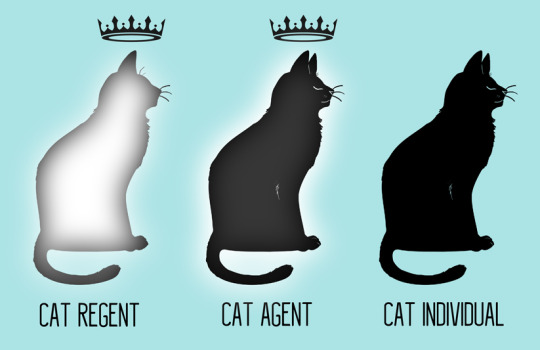
Regent:
A deity-like figure that represents the gestalt of all cats, the parent of all cats, the archetypal essence of what it is to be a cat; the quintessential cat-ness. A nonphysical being, but one that in this case, currently does have living physical counterparts (Regents of extinct taxa would not, but are still relevant).
If I were to meditate with the goal of entering a trance state and communing with an archetypal being that identifies itself as Domestic Cat, this would be the Domestic Cat Regent.
Individual:
A single cat entity. May be a living cat, a spirit housed in remains of a once living cat, or the incorporeal spirit of a cat.
The feral cat skull I have on my mantle was untrusting of humans in life, and remains so in death. The spirit housed in this skull is generally uncommunicative, and is another example of a Cat Individual.
Agent:
An individual as above, that is acting on behalf of another being, such as a deity or a tutelary regent.
Once, while meditating in my bedroom, I attempted to contact Bast using a small statue of Her image, but I wasn’t able to make a connection.
My cat-son had been sprawled on my bed behind me, and we had been mutually ignoring each other as he didn’t usually involve himself in my magical practice.
This time however, Bast decided to use him as a vessel for communicating with me.
‘Why use a statue when there is a real live cat right here?’ She had chided me affectionately.
In this instance my cat-son was operating in the capacity of agent, albeit for Bast rather than Cat Regent-in this instance, the human equivalent could be deemed to be aspecting or possession.
In my previous post, I described how a living individual domestic cat had acted as a messenger for Lilith. This cat was also acting as an agent.
If I wished to communicate with Cat Regent, I may set up my feral cat skull on my altar to act as an agent.
If Eurasian Lynx Regent was keen to communicate with me, it may use this skull as an Agent. Note-I have had American Badger Regent send me messages through a raccoon skull, so the species don’t necessarily need to be closely related-however if one were attempting to make contact rather than receive, a closer connection may be more viable.
I chose these terms as they are reasonably self-explanatory with context; How would this play out in conversation for example? Someone, upon learning that I work primarily with nonhuman animal energies, may ask me ‘what is your spirit animal?’
I would answer ‘I’ve been working a lot with coyotes lately, but Ringtail Possum Regent has been looking after me for many years.’
This would be referring to the many individual coyotes I work with, but the more abstract nature of my relationship with Ringtail Possum.
If anyone has any thoughts on this method for labeling and classifying types of interactions with animistic spirits, I’d love to hear them.
0 notes
Text
A return
I enjoy walking as a form of simple, aimless meditation.
Last night I went for walk along an unfamiliar path, and got thoroughly lost deep in the suburbs.
After some time, I met a cat. A beautiful, muscular and trusting black and white feline, who meowed at me until I noticed it; I was listening to music and may have tripped over it otherwise.
The cat had a message for me.
After I dispensed a payment of ear-scratches, it wandered off.
I sat down on the ground and felt so overwhelmed with fatigue, slipping into a light trance was unavoidable.
In this trance state I was transported to a scene I recognized as one I had painted many years ago, when She was the subject of many of my artistic endeavours.
Lilith, with grey skin, pointed ears, silver hair, and a featureless face except for her large, solid red almond eyes.
In this instance, a long serpent-like tail coiled behind her instead of legs. The way she appeared to me when I was younger was not always consistent, but always easily recognizable.
Before her, She held a brass bowl, filled with blood. She was pouring it on the sand. The bowl never emptied. Behind us, in the distance was a silent, still sea.
I’ve got bad RSI pains in my hands at the moment from overindulging in PC use.
I put my hands under the blood flowing from her bowl, letting it wash over my hands, and the pain disappeared for as long as the blood covered them.
We had a conversation without words.
I don’t remember what happened to our relationship. We had been close when I was a teen. Perhaps I had drifted away from her, thinking I needed to, because of my gender transition. She put that notion aside, reminding me my body is filled with blood, plump with it.
My concentration slipped and the pain returned. I got up and after over an hour of listening for trains and main roads, managed to find my way back to my house.
1 note
·
View note
Text
Altered states, and defenestrating Cartesian dualism
I had a pretty unhappy youth.
Was this really all there was to reality? When it wasn’t busy being traumatizing, it was agonizingly dull.
For more insight into what this was like, I recommend giving a listen to this recording of Peggy Lee’s ‘is that all there is?’.
As a cynical young teen I began to feel the white, suburban world I lived in was culturally and spiritually bankrupt, with most people around me only paying half-hearted lipservice to Christianity. I was deeply unhappy, culturally disconnected and spiritually unfulfilled. I was also a bit of a teen-goth cliche.
This disenchantment was likely one of the things that pushed me towards a pagan path-particularly one that heavily uses shamanic techniques.
Being able to escape into stories, games, meditation, dancing or anything else resembling altered states wasn’t just a tool for survival, but something that has made my world much richer. I’ve never been a fan of recreational drug use as my perception of reality is weird enough already and I don’t want to endanger my tenuous mental stability.
As I matured I began to notice and appreciate parallels in the culture I was immersed in to those supposedly more magically inclined ones from the distant and romanticized past I’d only read about in books. AFL football could be conceptualized as ritualized battle between clans; contemporary dance a form of shapeshifter magic; BDSM play spaces a way of inducing altered states of consciousness. People I’ve encountered participating in the rave scene would often talk about transcendent experiences beyond what could be explained by recreational drug use. Many of us know a born storyteller, someone able to spin engrossing tales whenever they feel the inclination. Art of all forms often utilizes the power of bringing about altered states. Much of the art and media I have consumed, created or participated in has been powerfully transformative. I’ve read many books that have changed me forever.
A few years ago I attended an avant-garde theater performance with a group of friends. The audience awaited direction outside in the cool night air, at the corner of an inner city alley. At the appointed time, a Charon-like figure appeared to usher us to the nearby ‘secret’ location of the performance; a dimly lit and intimate bar.
The outcome of the story depended on the reaction and participation of the audience. The performers wandered about and mingled with the people in attendance. The lighting, mystery and anticipation quickly created a liminal space. There was magic afoot.
One of the performers, who had taken on the role of Lilith was particularly compelling; but there was something deeper at play here than dedicated and immersive acting. It was her. We all felt it.
Myself and my friends were all deeply emotionally/spiritually impacted by what transpired. It was on my mind for several weeks afterwards.
More recently, Friday night was a particularly special night for the LARP group I semi-regularly attend. The warband the Briarwolf Pact was disbanding, and this was honored with some role-play and ceremony.
Within the fantasy universe Swordcraft takes place in, the Briarwolves are ancestor revering, wild warriors whose tenets include the importance of balance, and of family. During the battle, we were lead by the ancestors themselves-members of the warband dressed with garlands of blue glowing lights as a representation of their otherworldly nature.
Somebody on the field on the opposing side was playing the bagpipes and people were beating their shields to the rhythm of war. I have just enough Scottish ancestry in my blood to love the sound of bagpipes. It was a thrilling experience and emotions ran high. I dare say, it was magical.
As an animist, my view of the world is one that makes no material distinction between the ‘mundane’ and the ‘spiritual’; it rejects Cartesian dualism. Daily life however, is a grind. Ennui and suffering make losing the childlike wonder at the beauty of the universe all too easy. Making time for structured magical ritual isn’t always possible.
But sometimes magic seeps through into any spaces which invoke liminality and cannot be ignored, no matter how secular; those of artistic or emotional expression especially.
If you look for it, you might find it in some unexpected places too.
0 notes
Text
Why I don’t work with dead babies
Skinning, dressing or otherwise prepping a once-living being is an intimate procedure. The body is not decontextualized, wrapped in plastic and lit with fluorescent lighting like the most common experience of meat in urban areas.
It’s not for everyone.
The infant mortality rate for many non-human animals is extremely high; finding that bodies are very young is a common experience among those who seek them out. Many people I’ve spoken with are dispassionate over, or unconcerned by working with baby animals. Some find the experience distressing, but persevere nonetheless.
It’s common in the Vulture Culture community to have no qualms about processing the bodies of infants or juveniles.
Newborn or foetal animals are often prized to be processed into wet specimens (a whole specimen preserved in fluid, sealed in a jar). Some anomalies such as cyclopic calves, attractive to collectors, rarely live beyond infancy, making it a necessity.
Preserving bodies of the young dead has its own set of challenges.
Baby birds don’t have feathers worth preserving, and the skin of smaller mammals is very thin and fragile.
The skulls of infants are not yet fully fused; this allows them to grow rapidly in life, but easily fall apart in death. They can be re-constructed later, but this requires patience, time and skill. Young bones are delicate, sometimes even almost spongy.
I don’t collect wet specimens because my interest in keeping remains is less scientifically motivated than some. I prefer the tactile experience of being able to hold my specimens-keeping dead things in jars is too clinical for my taste.
Less rationally, I’m also nervous they might get broken-like little unexploded biohazard grenades.
But I also have a more personal reason for passing over infant dead bodies when I find them.
Deceased babies may have stronger ties to the spirit world than this one; they haven’t inhabited their bodies for very long, after all. A newborn rat may or may not have as much knowledge of the fundamental state of Ratness, and what it is to be a rat, and live as a rat, than an older one.
Perhaps Rat, or any other Archetype Spirit progenitors are impartial towards the age of their children when they pass on. Perhaps not-I don’t claim to know.
But since I work with ‘skin spirits’, it makes sense to avoid ones who were badly mistreated in life (including violent deaths and fur farms), or infants.
An experience I had many years ago, early in my practice, solidified this rule. I found a baby bird that had fallen onto the ground and died. I hadn’t been collecting remains for long, so I was a little over-eager in processing things that I’d pass over today.
I went into a meditative journey/trance state to ask permission of the baby bird if I could take its body, and to perform my usual funerary rites when doing so.
The young bird was very wobbly, probably only a few days past hatching, but agreed that I could keep its bones.
The mother of the baby bird swooped me repeatedly, making frantic distress calls. She was upset and grieving, and I ended the meditation. I did not keep any of those remains, and the experience is one I’ll never forget. Consent and caring for the dead, and respecting their wishes are important aspects of spirit work. As animals all develop at different rates, I don’t have any strict guidelines for age, but it’s something to consider when bringing home a new specimen.
This experience set me on a path of a deeper understanding of consent and the proper care of the dead; a simple yes/no answer is not sufficient. The circumstances that surround the question need to be delicately examined, and personal responsibility must be taken. After all, these are not simple objects and should not be treated as such; they deserve all the reverence and care one can provide.
3 notes
·
View notes
Text
On trusting yourself-featuring Fox and Coyote
I’m very prone to self-doubt; a self doubt beyond a healthy skepticism and desire to keep ego in check, at that.
To me, Fox is illusive, the secret keeper, the shadow trickster, hunter and prey. I have never once gotten a clear, good look at a living wild fox.
As a teen living on the Mornington Peninsula, a gang of them would slink across our front lawn, activating the motion-sensor porch light. My mother often saw them, but no matter how fast I rushed to the window, I never did.
I’ve skinned and tanned foxes killed by hunters, and seen unfortunate souls crumpled up on roadsides aplenty. Sometimes I’ve witnessed a blurry, fleeting glimpse of one out of the corner of my eye, so swift that I began to doubt it was real immediately after.
Early in my practice, I worked with Fox energy extensively. I found a very old antique fox tail, inhabited by a lively skin-spirit that loved to dance. I’d wear it on my belt for special occasions and public rituals.
A few years later a companion of mine gifted me with the face skin of a coyote. It was badly crumpled up and it’s skin-spirit grumpy (years later, reshaping it improved his disposition significantly). Knowing Coyote’s reputation I was somewhat aghast. I wasn’t ready for that kind of responsibility. I packed it away and largely forgot about it-it wasn’t the right time.
I went on a hiatus from spirit-work.
Later on, I acquired three much more personable Coyote skin-spirits. A skull, who sits on my altar, a tail, and another face skin. I have no doubt they chose me.
I began to wear at least one of my two tails as part of my regular attire. For a short time I wore both-on opposite sides of my body-as Fox and Coyote have an antagonistic relationship, with Coyote nipping at Fox’s heels.
The fox skin-spirit expressed a desire to retire from being worn; I’d had it for over a decade, and it must be older than that by several more. This was the moment that Fox energy slipped off the main stage of my life.
Enter, in force, the coyotes.
They have much to teach me, and I appreciate the company as they trot along by my side. Coyotes are generally warm, playful and chatty. A different kind of trickster; the bold, brash type that will encourage you to build a tower, only to push you off it so you learn humility.
Now, thinking about the past, that ever-present sense of doubt began to creep in.
I began to wonder if the connection I had with Fox was genuine. Did I simply want to work with foxes because I thought they were glamorous, alluring? Did I never see one because I had chosen them, and not the other way around? In my practice, cooperation is vital-the strongest bonds are the ones we don’t choose/initiate.
In a dream, ever the realm of mysteries, a handsome red fox appeared, very deliberately letting me get a good look at it before disappearing back into the scrub, going about its fox business. A sign that our connection was real, that I shouldn’t doubt it’s validity.
Fox taught me to keep chasing the intangible, to trust my intuition. To keep reaching for that goal, the one it’s too dark to see and just out of reach, but to keep stretching until I can brush it with my fingertips.
I best not forget it.
0 notes
Text
Manticore magic-a meandering ramble through my pagan practice
What pagan paradigm do I work with is a question I’ve been asked many times in my life, and I’m never quite sure how to answer.
Eclectic, neopagan, animist, hedgewitch, void walker, shamanistic spirit worker, magic user, skin priest-these are all terms that I’ve used to describe myself, but none of them fit me comfortably. As soon as I find one that feels comfortable, I quickly grow out of it. Telling people I primarily work with animal spirits is usually enough for casual introductions, but it’s not enough for me. I want more, ever hungry, ever curious, ever expanding my world.
I have neither a solid historical pagan tradition backing me up, nor a cultural one. Pop culture provides my mythical epics, video games my warrior heroes, books my spiritual insight. I’m a product of the cultures I grew up in, here in Melbourne Australia, and continue to participate in.
Maybe one day I’ll be able to piece together a coherent enough framework that can be used as the basis of a new pagan spiritual paradigm.
At the very least, this will be my record. This is my path, the one I carve out for myself, making my own truth.
0 notes